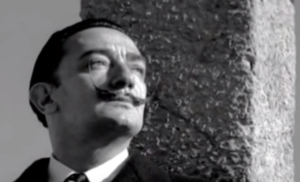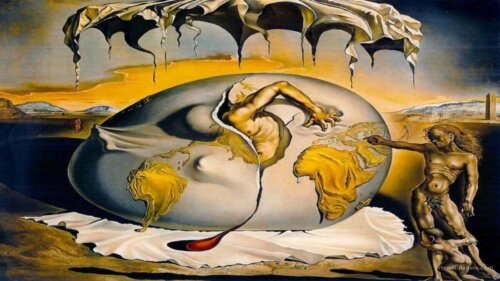Was Salvador Dalí a Brilliant Madman?

Salvador Dalí was a flamboyant, provocative, controversial, and brilliant madman. He’s one of the most eccentric figures in the world of the arts, no doubt. Defining him is somewhat risky though. This is because his life and work have always gone hand in hand. He has a well-defined identity and his work is a glimpse into his personality. He doesn’t really fit into a category and is beyond comparison.
Dalí is one of those magicians who’s artistic imprint is evident in everything he did. You don’t have to be an art expert to identify one of his paintings, for example. Thus, his style is easily recognizable and you can’t mistake it for anyone else’s.
This artist is the quintessential surrealist and one of the most prolific artists of the 20th century. He also masterfully reflected his love for classical and Renaissance art during his hyperrealist period, however. In addition to his abundant pictorial work, he was also a sculptor, fashion designer, writer, and filmmaker.
His is a whole artistic legacy that served as a way to express his hallucinations and dreams through visual language. The dream world has a strong presence in his work. He also dealt with religious symbolism, like few others. There are many iconic images throughout his work. Controversial and extravagant, Dalí was so much more than an artist.
“The only difference between me and a madman is that I’m not mad.”
-Salvador Dali-

The early years of a brilliant sort of madman
Salvador Dalí was born in Figueras on May 11, 1904. It isn’t easy to know what his childhood was like, though. In fact, he used to say that, as a child, he would burst into anger and rage towards his schoolmates and parents. Nevertheless, it seems that, despite everything, he was a very intelligent boy whose artistic skills stood out early on.
Dalí had an older brother, whose name was Salvador as well. However, he died at the age of three, and he was born soon after. He often mentioned he carried the burden of his late older brother. It was as if a part of him had to die so that Dalí could become immortal.
The idea of a dead brother whose essence lingers in the living in an infinity of artistic manifestations, be it in the form of a double or an identity crisis is quite evident in his work. Dalí wasn’t an exception and one can see this fact could’ve caused him an identity crisis.
In 1921, he was still quite young when he decided to move to Madrid to study art. Dalí was part of one of the cradles of the great Spanish artists of the 20th century. In this place, he coincided with other remarkable people of the era, such as Luis Buñuel and Federico García Lorca.
However, his time at the school was marked by his anti-government political activities, which led to his brief imprisonment and subsequently got him expelled from the school.
Knowing surrealism
Salvador Dalí traveled to Paris in 1928, a place that led him to his first contact with surrealism. Surrealism is a quasi-poetic movement in which the other arts are mere artistic expressions of poetry.
Surrealism, moreover, draws on Freudian influence in regard to dreams and, consequently, goes beyond realism. However, this artistic movement ended up adopting an infinity of political connotations. Surrealists believed the artistic revolution should go hand in hand with the political revolution.
Dalí distanced himself a little from this idea and chose to change his own reality. Thus, he didn’t have to be involved in changing the world and developed what he called the “paranoid-critical method”. He described it as a state in which deception can be simulated while maintaining sanity. He met Gala, the woman who would become his wife and muse around the same time.
Dalí’s unmistakable style and his exaltation of himself and his work also got him expelled from the Surrealist movement. While his pictorial work and his exploration of film and sculpture gained more recognition, the opposite was true of his own image. People had begun to lose respect for him.
The truth is Dalí was quite narcissistic and he loved being the center of attention, in the spotlight. Are you familiar with a picture of Dalí walking an anteater? Dalí was undoubtedly extravagant and pushed art to the limit.

The work and legacy of a brilliant madman
Death and decadence mixed with marked eroticism left their mark on Salvador Dalí’s entire work. The painter’s work is a projection of the psychoanalytic theories of his time, which greatly influenced his work and personal life.
Dalí used the psychoanalytic technique of free association to capture the content of his unconscious on his canvases. It decomposed reality or even deformed it by using fetishes, religious symbols, magical creatures, and fantastic machines. It projected his own personal catharsis and metamorphosis and evoked chaos. His is an unmistakable kind of art that, despite the years, continues to be popular.
Salvador Dalí passed away in 1989, after a life full of controversies, eccentricities, and masterpieces. His magnificent talent led to success, but also to much criticism. People talked about his controversial life and personal image as much as his work.
Was Dalí a brilliant madman? Brilliant, indeed; eccentric, definitely. If he had a psychological disorder, he managed to extract his own essence from it and express it in such a way that it never stops being relevant.
Salvador Dalí was a flamboyant, provocative, controversial, and brilliant madman. He’s one of the most eccentric figures in the world of the arts, no doubt. Defining him is somewhat risky though. This is because his life and work have always gone hand in hand. He has a well-defined identity and his work is a glimpse into his personality. He doesn’t really fit into a category and is beyond comparison.
Dalí is one of those magicians who’s artistic imprint is evident in everything he did. You don’t have to be an art expert to identify one of his paintings, for example. Thus, his style is easily recognizable and you can’t mistake it for anyone else’s.
This artist is the quintessential surrealist and one of the most prolific artists of the 20th century. He also masterfully reflected his love for classical and Renaissance art during his hyperrealist period, however. In addition to his abundant pictorial work, he was also a sculptor, fashion designer, writer, and filmmaker.
His is a whole artistic legacy that served as a way to express his hallucinations and dreams through visual language. The dream world has a strong presence in his work. He also dealt with religious symbolism, like few others. There are many iconic images throughout his work. Controversial and extravagant, Dalí was so much more than an artist.
“The only difference between me and a madman is that I’m not mad.”
-Salvador Dali-

The early years of a brilliant sort of madman
Salvador Dalí was born in Figueras on May 11, 1904. It isn’t easy to know what his childhood was like, though. In fact, he used to say that, as a child, he would burst into anger and rage towards his schoolmates and parents. Nevertheless, it seems that, despite everything, he was a very intelligent boy whose artistic skills stood out early on.
Dalí had an older brother, whose name was Salvador as well. However, he died at the age of three, and he was born soon after. He often mentioned he carried the burden of his late older brother. It was as if a part of him had to die so that Dalí could become immortal.
The idea of a dead brother whose essence lingers in the living in an infinity of artistic manifestations, be it in the form of a double or an identity crisis is quite evident in his work. Dalí wasn’t an exception and one can see this fact could’ve caused him an identity crisis.
In 1921, he was still quite young when he decided to move to Madrid to study art. Dalí was part of one of the cradles of the great Spanish artists of the 20th century. In this place, he coincided with other remarkable people of the era, such as Luis Buñuel and Federico García Lorca.
However, his time at the school was marked by his anti-government political activities, which led to his brief imprisonment and subsequently got him expelled from the school.
Knowing surrealism
Salvador Dalí traveled to Paris in 1928, a place that led him to his first contact with surrealism. Surrealism is a quasi-poetic movement in which the other arts are mere artistic expressions of poetry.
Surrealism, moreover, draws on Freudian influence in regard to dreams and, consequently, goes beyond realism. However, this artistic movement ended up adopting an infinity of political connotations. Surrealists believed the artistic revolution should go hand in hand with the political revolution.
Dalí distanced himself a little from this idea and chose to change his own reality. Thus, he didn’t have to be involved in changing the world and developed what he called the “paranoid-critical method”. He described it as a state in which deception can be simulated while maintaining sanity. He met Gala, the woman who would become his wife and muse around the same time.
Dalí’s unmistakable style and his exaltation of himself and his work also got him expelled from the Surrealist movement. While his pictorial work and his exploration of film and sculpture gained more recognition, the opposite was true of his own image. People had begun to lose respect for him.
The truth is Dalí was quite narcissistic and he loved being the center of attention, in the spotlight. Are you familiar with a picture of Dalí walking an anteater? Dalí was undoubtedly extravagant and pushed art to the limit.

The work and legacy of a brilliant madman
Death and decadence mixed with marked eroticism left their mark on Salvador Dalí’s entire work. The painter’s work is a projection of the psychoanalytic theories of his time, which greatly influenced his work and personal life.
Dalí used the psychoanalytic technique of free association to capture the content of his unconscious on his canvases. It decomposed reality or even deformed it by using fetishes, religious symbols, magical creatures, and fantastic machines. It projected his own personal catharsis and metamorphosis and evoked chaos. His is an unmistakable kind of art that, despite the years, continues to be popular.
Salvador Dalí passed away in 1989, after a life full of controversies, eccentricities, and masterpieces. His magnificent talent led to success, but also to much criticism. People talked about his controversial life and personal image as much as his work.
Was Dalí a brilliant madman? Brilliant, indeed; eccentric, definitely. If he had a psychological disorder, he managed to extract his own essence from it and express it in such a way that it never stops being relevant.
This text is provided for informational purposes only and does not replace consultation with a professional. If in doubt, consult your specialist.







